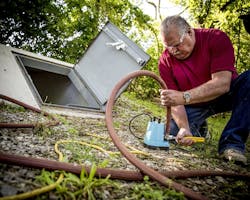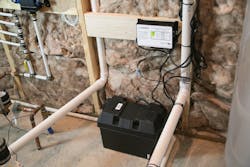Weather the Weather
Tom Miller can be reached at [email protected]. Jeff Wilder can be reached at [email protected].
undefinedWhatever the weather – from heavy spring rains to winter snow accumulations – pumping systems must continue to operate to deliver water and remove wastewater and storm water runoff. Electrical lines can go down and communication systems might be interrupted, yet water systems must continue to perform for homeowners, communities and businesses. This has never been more evident than in today’s unpredictable weather environment.
What can pump installers, owners and operators do to mitigate downtime or disruptions caused by weather events, changing water levels and more? The solution often comes down to preparations that start long before a pump is installed and extend to having the right backups and maintenance plan in place for whatever occurs over the life of the system. With some critical upfront planning, pump operators in the residential, commercial and municipal sectors can minimize the effects of the most common weather crisis: heavy water runoff due to excessive rain or snowmelt.
Considerations When Designing the Pumping System
Inclement weather is occurring more frequently, and temperatures are shifting year-round. In many ways, it seems that 100-year weather events are more common than ever.
The data backs this up. According to the U.S. EPA, scientific studies indicate that extreme weather events, such as heatwaves and large storms, are likely to become more frequent or more intense with human-induced climate change. EPA data also suggests that larger, single-day precipitation events are happening more often – with nine of the 10 most extreme precipitation years occurring since 1996. This is not just rain.
Major snow accumulations can melt all at once, overwhelming a system.
As pump operators and homeowners know, all this water must go somewhere, and it typically runs to the lowest possible point. In residential and light commercial settings this means basements, underground parking garages, construction sites, loading docks, elevator pits and more become overrun with water.
Water and storm runoff also carry debris that must be handled quickly and efficiently while not clogging the pumping system. The water coming into a system can vary wildly, so having the right equipment in place is critical since – as the data indicates – “just in case” situations are becoming more common.
Right Size & Right Spot
For residential and light commercial settings, this equipment should include correctly sized pumps that can power up when needed and adapt to rising water levels. The ideal choices are sump pumps for general dewatering or a combo sump/effluent pump when debris is a concern.
In terms of light commercial spaces, it is also important to consider where equipment is placed. Can it be easily accessed in bad weather or during a flood? Can the pump be isolated or shielded so that excessive storm water debris will not get clogged in the system?
Consider also how the system operates in relation to the municipal system. If part of that system experiences an interruption, how will it affect what backups are needed?
In certain situations, multi-pump configurations can address a system’s need to meet a wide variation in pressures or flows by staging the number of operating pumps. Engineers can consider designing the system to meet increased flow or pressure conditions while offering the versatility of alternating operation across pumps for extended lifecycles.
For municipal settings, pumps are often part of large capital investments that are planned and vetted decades in advance. While these cannot be changed easily or quickly, they can be prepped and outfitted with equipment that keeps communities prepared to combat adverse conditions.
Controls, Drives & Monitoring
Just as important as the pumps themselves, are the controls, drives and monitoring mechanisms that are built into the system. Transducers or floats can provide critical input to keep operators ahead of potential overloads or issues. Alarms can give maintenance personal time to resolve an issue before a pump or system gets damaged.
Nowadays, it is more common to access variable frequency drive technologies that have been specifically engineered to optimize the water pumping system. This can translate into an added layer of security for your system thanks to its built-in protections, communication protocols and even advanced setup and troubleshooting through smart devices.
Have a Backup Plan
Another consideration in water handling is backup pumping for water in unexpected places or when the water event exceeds the original pump’s capacity.
Designed for extreme portability and lightweight enough to keep on-hand for unexpected jobs, a mobile utility pump can temporarily handle clear water removal from basements, crawl spaces, loading docks and just about anywhere water can make an uninvited appearance in residential or light commercial spaces. These units can also help to prevent a permanent pumping unit from becoming overwhelmed, providing extra risk avoidance to keep homes and businesses of all sizes ready for the weather.
While having a backup utility pump is a great way to handle the unexpected, know that the unexpected has actually occurred before it does damage. This is especially important in areas that are visited infrequently. Installing small battery-operated high water alarms even in residential sump applications can alert the homeowner to an issue and prompt action before damage can occur. Many battery backup sump systems include this type of alarm, but options for a separate alarm are also available.
In addition to the base pumping equipment, it is important to have a full battery or generator backup that is correctly sized for the unit or units. When weather events occur, power will often go down. With battery backup, these critical pieces of equipment can continue to handle the excess water that will likely enter the area. With most homeowners storing valuable items in their basements, having a battery backup system acts as a secondary sump pump for flood protection and emergency dewatering.
These systems provide added peace of mind to avoid costly repairs during inclement weather and power loss. However, before choosing a generator, it is a good idea to check it against the system sizing. How well will it handle both short-term and long-term power interruption?
It is also possible for municipalities to implement similar – albeit larger scale – backup plans. In the event of power outages and electrical disruptions, consider backup pumping systems that operate off the grid, such as diesel-driven pump packages. Industrial-sized mobile diesel pumping units can be rented and on standby for communities of all sizes.
These portable pumping packages move a ton of water fast, and can be on standby when seasonal events are most likely to occur. Examples include major snowmelts in late winter/early spring, when rainwater approaches flood stage, etc.
Communities can even consider cost-sharing the leasing, purchase or maintenance of these pumps, creating a contingency plan for various municipalities all at once. Even communities that are revisiting their pumping installations and planning for retrofits can benefit from backup pumping units. A community could choose to size for a 50-year weather event and utilize a standby or shared fleet of backup pumps for worst-case-scenario situations.
Preparing & Checking Your Equipment Seasonally
Pump maintenance and inspection will also keep systems prepared for the unexpected. Doing quarterly test runs of equipment outside of a major weather event can ensure water is not rising while repairs are waiting to be made. This test run should include:
- Cleaning out any built-up debris or other barriers;
- Testing battery backup equipment;
- Inspecting the check valve to make sure the system is keeping water from coming back in;
- Checking for any blockage in the air bleed hole in the discharge piping (This commonly overlooked item is vitally important for preventing hidden airlock.); and
- Monitoring for pump vibration, including checking that connections are tight and not leaking. (Minimizing this factor will help ensure the pumping system is operating at its best during its lifecycle.)
When servicing installations and offering weatherproofing to-do lists for customers during the winter, also be sure to check for outside variables that can encourage flooding. Are snow and ice accumulating around a home’s perimeter? Are exterior pipes winterized to prevent freezing? While most people associate basement flooding with heavy rains, flooding can occur year-round. Leaks or burst pipes are common during the winter months, thanks to an accumulation of moisture.
For commercial or industrial pumps, be sure to inspect level control systems. Since these systems will control whether a backup will kick in if needed, they may also be permanently on standby and need a quarterly check for proper operation. At the same time, verify that the sensors and monitoring equipment that are in place are working correctly and that alarms are set to go off in predefined situations. Then, have protocols established for answering and responding to these alarms.
Taking these extra measures will mean a payoff in peace of mind for years to come. Weather events may be more common, but pumps can adapt and respond, keeping homes, businesses and communities safe and dry even as weather becomes more unpredictable. Upfront planning, preventive maintenance and best practices can provide homeowners, businesses and communities with the foundation they need to minimize weather events before they become crisis situations.



